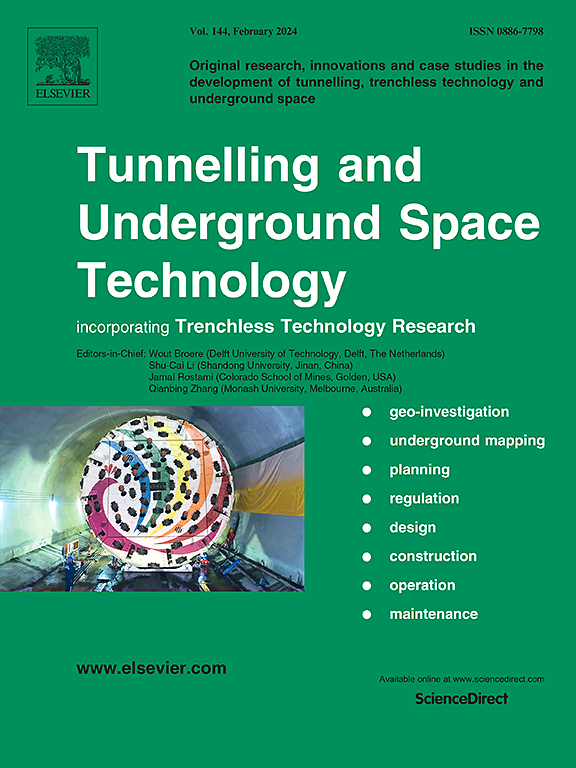利用多源地球物理和钻孔资料确定地质剖面的贝叶斯与集合学习相结合的方法
IF 7.4
1区 工程技术
Q1 CONSTRUCTION & BUILDING TECHNOLOGY
引用次数: 0
摘要
准确确定地下地层对地下基础设施的设计和施工至关重要。然而,利用稀疏和有限的钻孔数据圈定的地质剖面所涉及的不确定性可能是显著的。基于地震波的非侵入性地球物理方法在识别地层模式方面表现出色,为地质剖面分析提供了有价值的见解。因此,本研究提出了贝叶斯与集合学习相结合的方法,从多源地球物理和钻孔资料中确定地质剖面。利用基于钻孔数据的马尔可夫链蒙特卡罗(Markov Chain Monte Carlo, MCMC)模拟对不同地质界面的地球物理阈值进行校准,可以将多个地球物理剖面自动转换为地质剖面。随后,利用集成学习方法建立了鲁棒地质剖面。该方法的有效性通过新加坡一个站点的数据得到了验证,该站点使用了三种地震地球物理调查类型和五个井眼。结果表明,基于mcmc的贝叶斯校正可以显著降低地球物理阈值估计中的不确定性,大多数后验标准差降低约80% ~ 90%。综合地质剖面呈现融合的地层特征,地质界面和地层厚度变化更为合理。与训练钻孔和验证钻孔相比,准确率分别达到92.40%和91.23%,平均信息熵较低,仅为0.04,有效降低了不确定性。这些结果表明,所提出的贝叶斯方法能够从多源地理数据中确定地质剖面,提高了可靠性,减少了不确定性。本文章由计算机程序翻译,如有差异,请以英文原文为准。
A combined Bayesian with ensemble learning method for the determination of geological cross-sections using multi-source geophysical and borehole data
An accurate determination of subsurface stratigraphy is crucial for the design and construction of underground infrastructure. However, the uncertainties involved in geological cross-sections delineated using sparse and limited borehole data can be significant. Seismic wave-based non-invasive geophysical methods excel in identifying stratigraphic patterns and offer valuable insights for geological profiling. Thus, this study proposes a combined Bayesian with the ensemble learning method to determine geological cross-sections from multi-source geophysical and borehole data. Calibration of geophysical thresholds for distinct geological interfaces using Markov Chain Monte Carlo (MCMC) simulation based on borehole data enables the automated transformation of multiple geophysical profiles into geological cross-sections. Subsequently, a robust geological cross-section is developed using an ensemble learning method. The effectiveness of this method was validated by the data from a site in Singapore, where three types of seismic geophysical surveys and five boreholes were utilized. The results show that the MCMC-based Bayesian calibration can reduce significantly the uncertainty in geophysical threshold estimation, achieving about 80 % to 90 % reductions in most posterior standard deviations. The ensembled geological cross-section presents fused stratigraphic features with more reasonable variations in geological interfaces and formation thicknesses. Compared to training and validation boreholes, it achieves accuracies of 92.40 % and 91.23 %, respectively, with a low average information entropy of 0.04, indicating effective uncertainty reduction. These results have demonstrated the capability of the proposed Bayesian method to determine geological cross-sections from multi-source geodata with enhanced reliability and reduced uncertainty.
求助全文
通过发布文献求助,成功后即可免费获取论文全文。
去求助
来源期刊

Tunnelling and Underground Space Technology
工程技术-工程:土木
CiteScore
11.90
自引率
18.80%
发文量
454
审稿时长
10.8 months
期刊介绍:
Tunnelling and Underground Space Technology is an international journal which publishes authoritative articles encompassing the development of innovative uses of underground space and the results of high quality research into improved, more cost-effective techniques for the planning, geo-investigation, design, construction, operation and maintenance of underground and earth-sheltered structures. The journal provides an effective vehicle for the improved worldwide exchange of information on developments in underground technology - and the experience gained from its use - and is strongly committed to publishing papers on the interdisciplinary aspects of creating, planning, and regulating underground space.
 求助内容:
求助内容: 应助结果提醒方式:
应助结果提醒方式:


